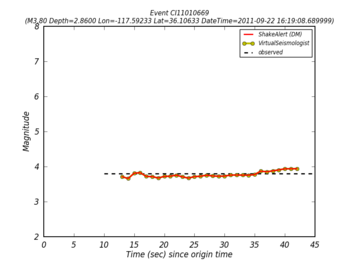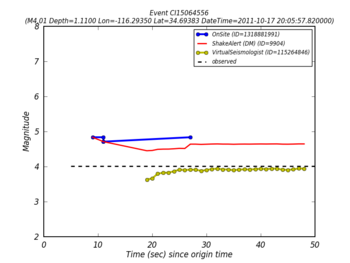Difference between revisions of "CTC Results"
| Line 9: | Line 9: | ||
Many of the ShakeAlert evaluation tests are based on comparing ShakeAlert triggers against an observational earthquake catalog. ANSS catalog has been selected as the authoritative catalog. | Many of the ShakeAlert evaluation tests are based on comparing ShakeAlert triggers against an observational earthquake catalog. ANSS catalog has been selected as the authoritative catalog. | ||
| − | Two catalog filter | + | Two catalog filter stages are applied to the raw catalog. First, all events outside the CSEP California Testing Region are dropped. Second, all events below M3.5 are dropped. The resulting catalog is the authoritative catalog used to compare ShakeAlert triggers against. |
| − | The | + | The ANSS earthquake catalog is plotted on California maps for different time frames, showing events over last one month, two months,four months, and six months. Maps of these event catalogs are posted here: |
| − | |||
| − | |||
| − | |||
*[http://scec.usc.edu/research/eew/summary/California/anss-tests/observations/ Filtered ANSS Catalog] | *[http://scec.usc.edu/research/eew/summary/California/anss-tests/observations/ Filtered ANSS Catalog] | ||
| − | ShakeAlert | + | The filtered ShakeAlert catalog contains only M3.5 and larger events within the geographical state of California. These catalogs for specific magnitude ranges and date ranges are plotted here: |
| − | *[http://scec.usc.edu/research/eew/summary/California/shake-alert/observations/ ShakeAlert Filtered Event Catalog] | + | *[http://scec.usc.edu/research/eew/summary/California/shake-alert/observations/ ANSS Raw and ShakeAlert Filtered Event Catalog] |
== ShakeAlert Cumulative Summaries == | == ShakeAlert Cumulative Summaries == | ||
| − | + | ShakeAlert cumulative summaries are based on a "selected" start date (current selected at 1 Sept 2011), through current date. The CTC retrieves all events in this time range from ANSS, then filters them in two ways. First, it removes all events less than M3.5. Second, it removes all events outside of the California CSEP Testing area. The CSEP testing area the includes all of California, and a little room on each edge including Nevada, Mexico, and the Pacific ocean. | |
| − | |||
The four cumulative summaries are: | The four cumulative summaries are: | ||
Revision as of 07:49, 9 February 2012
The CISN Testing Center (CTC) consists of scientific analysis software, CISN EEW algorithm performance reports, and earthquake observational data. This entry is a collection point for current and past results from the CTC testing center.
Contents
Filtered ANSS Catalog of Earthquakes
Many of the ShakeAlert evaluation tests are based on comparing ShakeAlert triggers against an observational earthquake catalog. ANSS catalog has been selected as the authoritative catalog.
Two catalog filter stages are applied to the raw catalog. First, all events outside the CSEP California Testing Region are dropped. Second, all events below M3.5 are dropped. The resulting catalog is the authoritative catalog used to compare ShakeAlert triggers against.
The ANSS earthquake catalog is plotted on California maps for different time frames, showing events over last one month, two months,four months, and six months. Maps of these event catalogs are posted here:
The filtered ShakeAlert catalog contains only M3.5 and larger events within the geographical state of California. These catalogs for specific magnitude ranges and date ranges are plotted here:
ShakeAlert Cumulative Summaries
ShakeAlert cumulative summaries are based on a "selected" start date (current selected at 1 Sept 2011), through current date. The CTC retrieves all events in this time range from ANSS, then filters them in two ways. First, it removes all events less than M3.5. Second, it removes all events outside of the California CSEP Testing area. The CSEP testing area the includes all of California, and a little room on each edge including Nevada, Mexico, and the Pacific ocean.
The four cumulative summaries are:
- Speed Test - Shows time system took to produce a warning. Does not include distribution time from ShakeAlert to users. (Time decision Module has event forecast - event origin time)
- Location Error - Shows difference between final observed location and forecast location (in km). Uses difference between epicenter locations (rather than hypocenter locations).
- Magnitude - Shows difference between (Observed - Forecast) final magnitude. Values above zero show over underestimated magnitudes. Negative values show overestimated magnitudes
- Magnitude Distribution - Shows x-y plot with observed mag on x and forecast mag on y. Accurate forecasts will fall on a diagonal line.
- ShakeAlert Cumulative Summaries At bottom of page
Daily Event Summaries
Performance summaries for specific earthquake are also plotted. These plots show time series of EEW parameters logged by ShakeAlert during real-time operations. The ShakeAlert algorithms log their trigger information, and the ShakeAlert Decision Module plots the earthquake parameters released to ShakeAlert users.
- Magnitude Forecast Time series - These present the performance of both the algorithms (Elarms, Virtual Seismologist, and OnSite) as well as the ShakeAlert Decision Modules.
- Location Error - Plot of the difference between
- Speed
- Magnitude Distribution
- ShakeAlert Cumulative Summaries Cumulative ShakeAlert Summaries]
Ground motion data used in associated ShakeMap for each event are logged in the ShakeCast monitoring pages.
CTC ShakeAlert Testing
As of September 2011, CISN Testing Center (CTC) processing now evaluates performance of the prototype CISN ShakeAlert EEW system. CTC evaluations are now based on earthquake parameter forecasts as logged by the CISN ShakeAlert system at U.C. Berkeley.
This testing include inputs from three algorithms (UCB Elarms, ETH Virtual Seismologist, and Caltech Onsite) as well as processing outputs from the ShakeAlert Decision Module.
The CTC automated testing center uses the following processing steps in its evaluation:
- Evaluations are run once per day.
- In order to let evaluation EEW alerts against "final" "stable" earthquake parameters, evaluations are delay for two days. That is on Tuesday, evaluations are done for the previous Sunday.
- Evaluation processing retrieves observed earthquake information from the ANSS catalog.
- ANSS catalog entries are filtered and earthquake below Mag 2.5 or outside the state of California are discarded.
- Evaluation processing retrieves ShakeAlert log files from operational server at UCB.
- For each ANSS earthquake, we look for one or more ShakeAlert triggers with origin time within 45 seconds of the observed earthquake.
- Plots are produced showing final (observed, ANSS) magnitude as compared to algorithm alerts from VS, OnSite, and ElarmS and Decision Module alerts (as sent to users).
The automated nightly evaluation results are posted at the following location.
CTC Interactive Performance Summaries
Prior to September 2011, CTC testing center produced interactive test results for individual EEW algorithms. These results lack information about the integrated ShakeAlert system. The most recent CTC development, described above, now include evaluation information about both individual algorithms as well as overall ShakeAlert performance. The interactive CTC performance summaries produced in the past are posted below, but this software is no longer under active development.
Interactive performance summaries are produced with a specific version of the CTC software in order to manage changes and improvements to the CTC processing software. These performance summaries are cumulative, with later summaries containing more events. Interactive results are reproducible by scientists as both the input EEW performance reports, and processing source code, are available from the CTC testing center.



